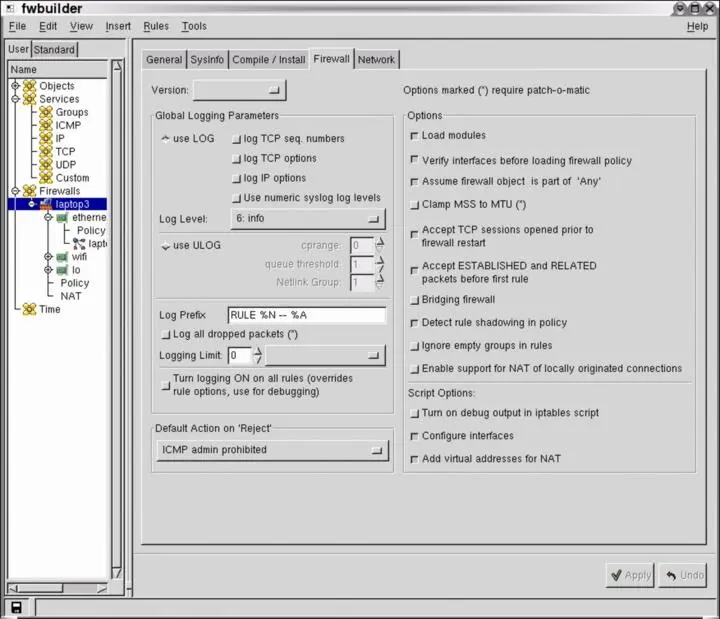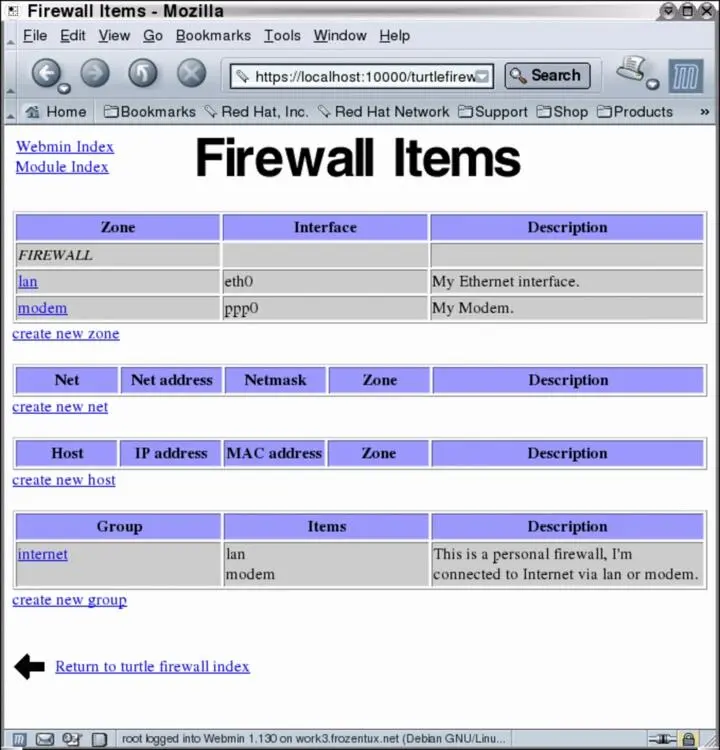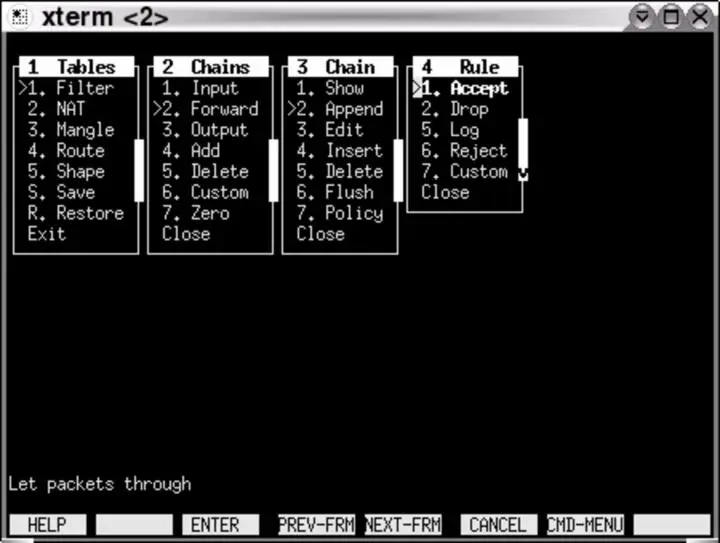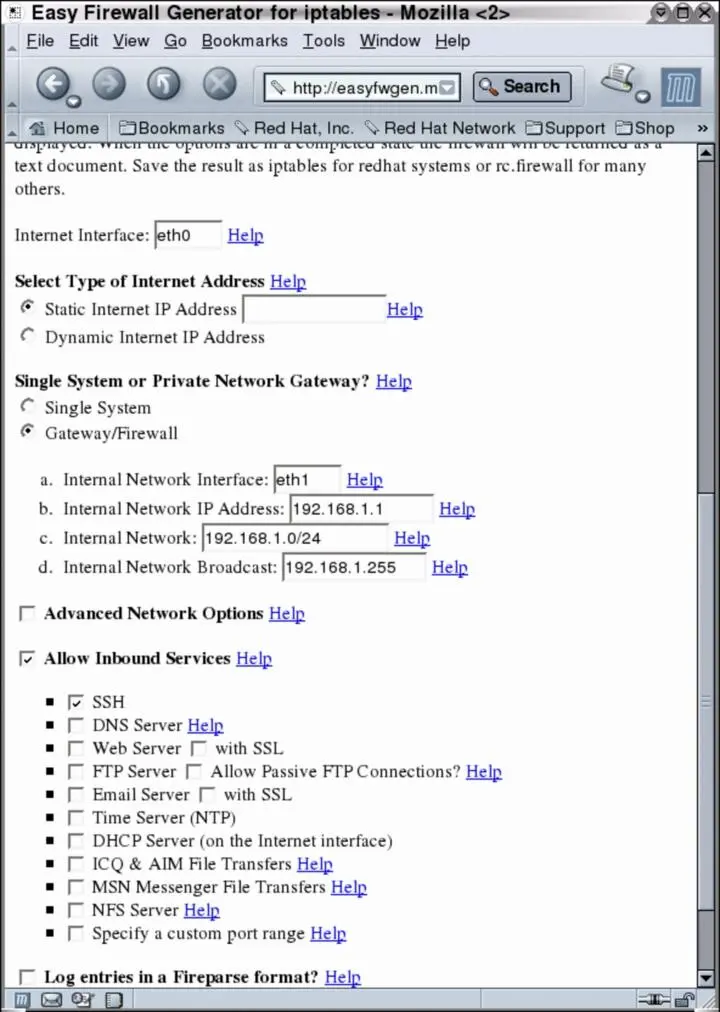Oskar Andreasson - Iptables Tutorial 1.2.2
- Название:Iptables Tutorial 1.2.2
- Автор:
- Жанр:
- Издательство:неизвестно
- Год:неизвестен
- ISBN:нет данных
- Рейтинг:
- Избранное:Добавить в избранное
-
Отзывы:
-
Ваша оценка:
Oskar Andreasson - Iptables Tutorial 1.2.2 краткое содержание
Iptables Tutorial 1.2.2 - читать онлайн бесплатно полную версию (весь текст целиком)
Интервал:
Закладка:
Limit-match.txt
The limit-match.txtscript is a minor test script which will let you test the limit match and see how it works. Load the script up, and then send ping packets at different intervals to see which gets through, and how often they get through. All echo replies will be blocked until the threshold for the burst limit has again been reached.
Pid-owner.txt
The pid-owner.txtis a small example script that shows how we could use the PID owner match. It does nothing real, but you should be able to run the script, and then from the output of iptables -L -v be able to tell that the rule actually matches.
Recent-match.txt
The recent-match.txtscript is a small example of how the recent match can be used. For a complete explanation of this script take a look at the Recent match section in the Iptables matches chapter.
Sid-owner.txt
The sid-owner.txtis a small example script that shows how we could use the SID owner match. It does nothing real, but you should be able to run the script, and then from the output of iptables -L -v be able to tell that the rule actually matches.
Ttl-inc.txt
A small example ttl-inc.txtscript. This script shows how we could make the firewall/router invisible to traceroutes, which would otherwise reveal much information to possible attackers.
Iptables-save ruleset
A small example scriptused in the Saving and restoring large rule-sets chapter to illustrate how iptables-save may be used. This script is non-working, and should hence not be used for anything else than a reference.
What's next?
The chapter you have just read basically gave you a brief overlook of all the different scripts that are available with this tutorial and the basic idea that they are trying to bring across to you. Hopefully it has been able to explain something at the very least.
The next chapter will discuss some different graphical user interfaces that are available for iptables and netfilter. This is far from a complete listing of all the different interfaces available, but as you can see, there are quite a lot of othem. These interfaces mostly tries to simplify creating iptables scripts for you, and for simple setups they are more than enough most of the time. At other times, you may have higher and more complex needs and you must have to write your own script none the less.
Chapter 15. Graphical User Interfaces for Iptables/netfilter
One side of iptables and netfilter that we haven't looked at very much yet, is the graphical user interfaces that are available for iptables and netfilter. One of the biggest problems with this is that netfilter is a very complex and flexible setup, that can perform the strangest of tasks. For this reason, it can become a very daunting task to create a GUI for netfilter.
Several persons and organisations have tried to create GUI's for netfilter and iptables, and some have succeeded better than others, while others have given up after some time. All have different reasoning behind their tries as well, so it isn't an easy task to show them all. However, this chapter is a small compilation of some of the GUI's for iptables and netfilter that may be worth looking at. Suggestions on others to add are always welcome.
fwbuilder
Firewall Builder, or simply fwbuilder, is an extremely versatile and powerful tool that can be used to build your own firewalls, or to maintain several firewalls for that matter. It can be used to create policies for several different types of firewalls, including iptables (Linux 2.4 and 2.6), ipfilter (freebsd, netbsd, etc), openbsd pf, and, a module that must be bought, Cisco PIX.
Fwbuilder has, as you can see, a very big audience and is well taken care of and continues to be developed. It is run on a separate host system, where you create the policy files, and then copy them over and run them on the target system. It is able to handle everything from very simple rulesets to large and rather complicated ones. It has extensive abilities to handle different versions and installations of iptables, by configuration of which targets/matches are available on each host system, etcetera. The end result may be saved in an xml file, or a system parsable configuration file (e.g., the real firewall scripts).

You can see the configuration of the "firewall" in the above example, and the main menus of the whole fwbuilder system. fwbuilder can be found at http://www.fwbuilder.org.
Turtle Firewall Project
Turtle Firewall is an excellent, yet simpler kind of user interface to iptables. It is integrated in something called webmin (a web administration interface). It is fairly basic, and neither as complex nor able to handle as complex changes as the fwbuilder package, but it is more than able to handle most simpler firewalls, as well as some more advanced ones as well.
One big advantage with Turtle Firewall is the fact that it is web-based, and hence can be remotely controlled in a totally different manner than with fwbuilder and most other tools. Of course, it also adds more of a security risk since webmin is a separate extra service running on the firewall itself.

The above screenshot shows the items page of the Turtle Firewall, where you can configure network interfaces and networks, and other items.

This final screenshot shows the turtlefirewalls main screen, and with the whole ruleset expanded at the bottom. The whole ruleset isn't showing, as you can see, but you get a good general idea of what it looks like in Turtle Firewall.
You can find the Turtle Firewall Project and more information over at http://www.turtlefirewall.com/.
Integrated Secure Communications System
The Integrated Secure Communications System, or shortly ISCS, is still undergoing development, and no public version has been released. However, this looks like it will become an extremely helpful tool once it is finished. The developer has very high standards, and this is the main reason that it has not been released yet. ISCS integrates several functionalities into a single suite of administration and management user interface. Basically this means that once this project is released, you will be able to fully configure all your firewalls from a centralized point using a single GUI, including VPN's, VLAN's, Tunnels, sysctl's, etcetera.
The main attack angle that the developer(s) of ISCS has, is to simplify management and administration and to remove tedious work for the administrators, so to save as much work hours as possible for the administrators. This is done by putting together policies, and then the programs creates the rulesets and "pushes" them out to the "enforcements points" (e.g., firewalls, proxies, etcetera). The administrator doesn't actually "write" or "click" together the rulesets, just simply put together policies that are then enforced by ISCS.
This tool isn't finished yet, as of writing this. However, I have been in touch with the main developer of this project before, and this is indeed a very large project. When it is finished, I believe this will be one of the best tools on the market. Of course, time can only tell, but it is well worth mentioning here. You can find the ISCS project over at http://iscs.sourceforge.net/.
NoteThe main developer, John Sullivan, of ISCS has specifically asked me to ask people to join his development efforts. The project is very big, and he would definitely like as much help with the project as possible. If you are able to help, you are, in other words, more than welcome.
IPMenu
IPMenu is a very able program, yet simple to operate and not too demanding on resources nor bandwidth. It is a console based program, so it works perfect over an SSH connection for example. It works perfectly on machines running over a simple and old modem as well.
As you can see from the screenshot, it is able to handle all iptables functionality, including filtering, mangling and nating. It is also able to handle routing tables and bandwidth shaping and to save and restore rulesets. You can add new rules directly into the currently running iptables script easily, and handle all of the different tables. Including adding and removing custom chains.

As you can see from the screenshot above, the program is rather basic, but still able to handle most situations rather well. And first of all, it is very simple, and can be used for remote administration simply enough, and since it runs on top of ssh via a standard console, it should also be fairly secure. You can find the homepage of IPMenu at http://users.pandora.be/stes/ipmenu.html.
Easy Firewall Generator
Easy Firewall Generator is another interesting development when it comes to iptables and netfilter. Basically, Easy Firewall Generator is a PHP webpage where you specify options and specifics of your firewall, and once all of the configurations are done, you click a button, and the webpage spits out an iptables ruleset that you can utilize.
The script contains all the basic rules, and more specific ones to contain strange patterns in packets. It also contains specific IP sysctl changes that may be needed, loads necessary modules, et cetera. The whole ruleset is also written in a redhat init.d format.

This screenshot shows one of the final stages of configuring the firewall script that is about to be created by the script. You can find more information, and a working version of the Easy Firewall Generator at http://easyfwgen.morizot.net/.
What's next?
In this chapter we have looked closer at what can be done with some different graphical user interfaces, and other user interfaces as well. Note that there are several more user interfaces around on the market. This chapter has mainly given you an idea of the different types of firewall administration interfaces around on the market. Most of them are open source and free to use, while some will cost a bit of money to get full support or functionality from.
Chapter 16. Commercial products based on Linux, iptables and netfilter
This section was added so that corporations may have their products tested and added to this tutorial. If you are a company and would like to have your products tested and reviewed in this section, you are more than welcome to contact the author through usual channels (see the top of this tutorial). Mind you that this section is not the definite place to look for product testing. It is rather a try to offer something to all of the corporate producers of Linux based products, and who contribute to the development of GNU/Linux software.
Читать дальшеИнтервал:
Закладка:










